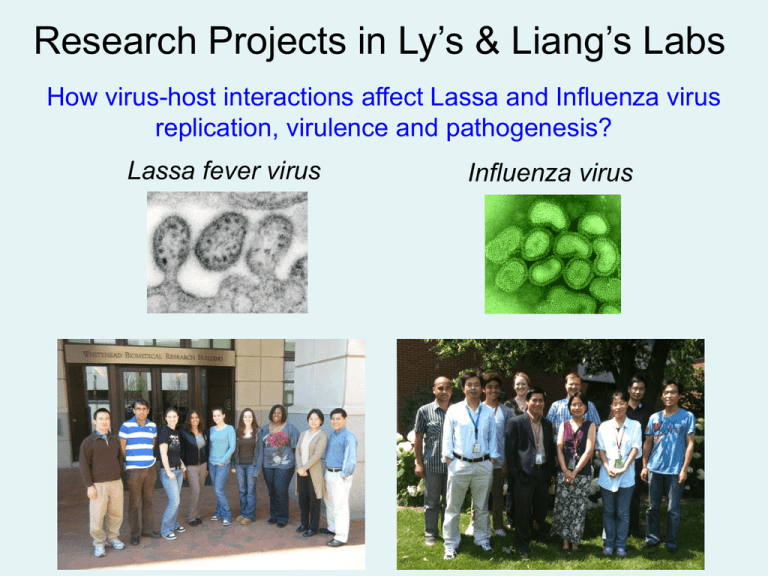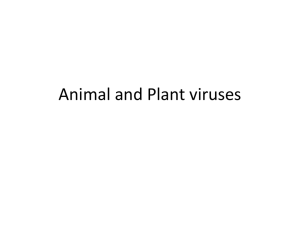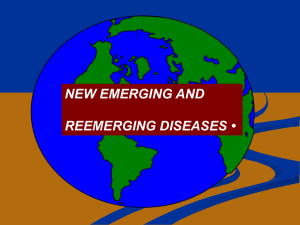Viral Infectious Diseases – Hinh Ly
advertisement

Research Projects in Ly’s & Liang’s Labs How virus-host interactions affect Lassa and Influenza virus replication, virulence and pathogenesis? Lassa fever virus Influenza virus Lassa Virus Causes Lethal Hemorrhagic Fever • Severe multisystem syndrome • Damage to overall vascular system • Severe symptoms often accompanied by hemorrhages Arenaviridae Bunyaviridae Filoviridae Flaviridae Rhabdoviridae ? 2 ambisense ssRNAs 3 (-)/ambisense ssRNAs (-) ssRNA (+) ssRNA (-) ssRNA Lassa (BSL4) Junin (BSL4) Machupo (BSL4) Guanarito (BSL4) Sabia (BSL4) Chapare (BSL4) Lujo (BSL4) Crimean-Congo H.F. (BSL4) Hantavirus (BSL3) Rift Valley Fever (BSL3) Ebola (BSL4) Marburg (BSL4) Kyasanur Forest Disease (BSL4) Omsk H.F. (BSL4) Yellow Fever (BSL3) Dengue (BSL2) Bas-Congo (BSL4) Overall Research Objectives & Approaches • Virulence factors & mechanisms • Virus-induced immune suppression • Pathogenesis proteomics 1. Animal model 2. reverse genetics 3. cell cultures 4. X-ray crystallography 5. Y2H & Pichinde virus infected guinea pigs Mass Spect Hemorrhagic fever-like syndromes in virulent Pichinde virus-infected guinea pigs Avirulent infection Virulent infection liver stomach intestine skin Pichinde virus: BSL2 arenavirus that is non-pathogenic in humans Multi-functional roles of Lassa nucleoprotein in viral RNA synthesis and host immune suppression N terminus of Lassa nucleoprotein has a cap binding pocket required for viral transcription C domain side view N domain Cap binding pocket Changjiang Dong, Ph.D., Univ of St Andrews, Scotland Cap binding Qi et al., December 2010, Nature pocket Qi et al., December 2010, Nature Lassa viral minigenome transcription assay LASV mini-genome with luciferase reporter gene Luc 5' + CMVp 1000 1 Y213A 10 R300A Y209A W12A K309A W164A F176A Y319A E266A K253A wt-15 wt-30 wt-62 w t-125 w t-250 w t-500 vector 10 100 R323A 100 WT Fold increase of RLuc activity 1000 1 LUC assay NP vector Fold increase of RLuc activity L 293T transfection CMVp Qi et al., December 2010, Nature C terminus of Lassa nucleoprotein has 3’-5’ exoribonuclease activity required for innate immune suppression 3’-5’ exoribonuclease domain Top view C domain 3’-5’ exoribonuclease cavity N domain Qi et al., 2010, Nature Hastie et al., 2011, PNAS Brunotte et al., 2011, JBC Hastie et al., 2012, PloS One Jiang and Huang et al., 2013, JBC, in press Roles of NP in mediating innate immune suppression and in enhancing viral replication Virus-receptor interaction Virus replication Pathogen-associated molecular patterns NP Short dsRNA Host’s pathogenrecognition receptors NP 5’pppRN P P P A RIG-1 Long dsRNA, higherorder structure NP MDA5 NP L Viral RNA synthesis IFN- Qi et al., December 2010, Nature Summary #1 • Pichinde virus-infected guinea pig as a good surrogate animal model for Lassa and other hemorrhagic fever diseases. • The reverse genetics systems of Pichinde virus (BSL2 pathogen) to identify the virulence determinants and to characterize the virulence mechanisms of Lassa virus infection. • Structure-function characterization of Lassa nucleoprotein has revealed unexpected roles for NP in mediating viral transcription and immune evasion. Possible collaborative projects 1. 2. 3. 4. 5. 6. Exploit known 3D structure of Lassa nucleoprotein for rational design of novel antiviral compounds Use Lassa minigenome assay to screen for compounds against viral transcription Use guinea pig animal model to test compounds against viral hemorrhagic fevers (coagulopathy, hearing loss, liver hepatitis, congenital viral infection) Use modified PICV reverse genetics system to deliver transgene into cells Use modified PICV reverse genetics system as novel vaccine vector platform Develop antiviral therapeutics targeting virus-host interactions FDA-approved drugs for influenza Class Agents Brand Name Approval year Viral strains Amantadine Symmetrel 1966 Flu A Rimantadine Flumadine 1993 Zanamivir (GG167) Relenza 1999 Flu A/B Oseltamivir (GS4104) Tamiflu 1999 Flu A/B M2 inhibitors Flu A NA inhibitors Problem: Rapid emergence of drug-resistant strains. - Develop novel anti-flu drugs - Use combination of diverse classes of anti-flu drugs - Targeting host components as an alternative antiviral approach Virus and host factors involve in influenza replication Virus release Virus entry Receptor Tyrosine Kinases TrKA Virus budding Protein Maturation fusion Genome Packaging Protein translation uncoating vRNP nuclear export vRNP nuclear import mRNA vRNA cRNA vRNA Viral RNA synthesis NF-κB signaling Liang, et al., 2005, J Virol Regan, et al., 2006, J Virol Liang et al.,, 2008, J Virol Kumar et al. 2008, J Virol Kumar et al. 2011, J Virol Kumar et al., 2011, AAC Liang, et al., 2012, PLoS One TrkA inhibitors strongly inhibit flu virus replication in vitro A/PR8 A/Aichi x31 7 7 6 6 5 4 3 2 1 5 4 3 2 A9 AG494 5 5 4 3 2 DMSO AG879 A9 AG494 4 3 2 1 1 1 DMSO AG879 B/Victoria 6 Virus yield [log(pfu/ml)] 6 Virus yield [log(pfu/ml)] 7 Virus yield [log(pfu/ml)] Virus yield [log(pfu/ml)] A/WSN 8 DMSO AG879 A9 AG494 DMSO AG879 A9 AG494 TrkA inhibitor inhibited flu virus replication in vivo and protected mice from lethal flu infection Kumar et al. JVI 2011 Kumar et al., AAC 2011 Possible Collaborations • Various convenient cell-culture based assays to screen for possible new drug candidates against different steps of influenza virus replication • Host signaling pathways (TrkA) play important roles in influenza virus replication and can serve as alternative anti-flu targets for drug screening. Other viruses of human and veterinary importance Avian influenza surveillance and host-pathogen interaction (Drs. Carol Cardona and Zheng Xing), swine influenza virus surveillance, virus-host interaction, and viral evolution in response to vaccination (Drs. Sri Sreevatsan, Montse Torremorell, Maxim Cheeran, Tom Molitor) Porcine respiratory and reproductive syndrome virus (PPRSV) and circovirus (PCV2): molecular virology & anti-viral immunity (Dr. Michael Murtaugh) Avian reoviruses (arthritis, runting, stunting syndrome and malabosorption in chickens and arthritis and enteritis in turkeys) (Dr. Sagar Goyal) Emerging phleboviruses (severe fever with thrombocytopenia – SFTS virus) and Heartland virus (HLV) (Dr. Zheng Xing): host innate immune suppression Infectious disease ecology: disease transmission and modeling of canine distemper, rabies, and parvovirus infections of African carnivores (lions) in the Serengeti ecosystem (Dr. Megan Craft) Cardona lab major projects • Phenotyping of influenza A viruses recovered during surveillance activities in relevant animal hosts. – Determining host susceptibility, infectious doses – Measuring host responses to infection – Goal: which virus or gene segment could contribute to human or animal disease? • The host and virus interactions of mixed infections with orthomyxo- and paramyxo–viruses. – Interactions in vivo and in vitro • The development of the chicken gut virome. Following the flow of the virome from breeders to their progeny through maturity in a farm environment. Elucida on of influenza-swine interac ons in popula ons Goal: develop an understanding of immune responses in emergence of viral variants in the swine popula on and develop new approaches for protec on against influenza Drs. Maxim Cheeran, Srinand Sreevatsan, Montsera Torremorel and Tom Molitor Viral behavior in the host Surveillance • Farm specific profile • geo distribu on • vaccina on effects on strain distribu on Biological Outputs 1. Understanding dynamics of gene c change in mixed infec ons (compe on versus viral/strain interference). 2. Popula on immunity. 3. Host-pathogen interac ons – a systems analysis using new genera on methods Swine Ecosystem endemic naïve Swine Influenza virus e vaccinated unvaccinated avian Transmission Dx Outputs 1. Novel in vivo viral diagnos cs and strain typing methods. 2. Biological assays to index subtype specific host responses to natural infec ons and vaccines In popula ons human Influenza A viruses • Strain specific rates • vaccina on effects on transmission • strain emergence • sequence profil s • Microevolu on in host environment • Cell-mediated immunity (CMI) • Humoral immunity • Maternal immunity Host response Swine influenza research Drs. Montserrat Torremorell and Srinand Sreevatsan • Swine influenza transmission and surveillance: – Models for influenza transmission using the pig as a model: • Evaluate the effect of immunity (i.e vaccination and passive immunity) on influenza transmission and dissemination • Evaluate the effect of immunity on influenza diversity and evolution • Determine virus genome diversity within and between animals throughout the course of infection using de novo sequencing techniques • Evaluate the role of fomites on transmission in experimental settings • Development of mathematical models for influenza spread in populations – Assessing subpopulations, routes and methods of influenza transmission under high risk interspecies transmission settings: • Assessment of animal subpopulations responsible for maintaining and spreading influenza • Determining the role of indirect routes of transmission (aerosols and fomites) to influenza exposure in animals and people – Methods to decrease influenza transmission and assessment of influenza dissemination in populations Xing, Zheng PhD Associate Professor Department of Veterinary Biomedical Sciences, CVM Research Interests: Pathogenesis and hostpathogen interaction of 1) avian influenza virus (AIV) & 2) bunyaviruses in human and animals AIV is a zoonotic pathogen that infects birds and humans. We study host responses and their regulations in infected birds and humans comparatively. Using genomic and other high throughput approaches, we study host-virus infections and identified cellular proteins that are required for viral replication. We expect to develop antiviral strategies based on the identified cellular components essential to viral replication. The bunyavirus we are studying is the one that causes severe fever with thrombocytopenia syndrome (SFTS) with a high fatality rate up to 15% in China. A similar virus, Heartland virus (HLV) has been identified in the Midwestern region of the US. We are studying the mechanisms how the viral infection suppresses host innate immunity. We have discovered a unique mechanism that HLV uses its nonstructural protein (NSs) to modulate host Collaborations: Promote mutual interest and Lab Commitment facilitate problem solving. Intellectual Property: Translate fundamental knowledge into useful products and tools. Advanced Training: Share expertise with sponsors and end users. Murtaugh Laboratory To discover and disseminate knowledge that enhances animal health; to prepare young scientists for careers in agriculture, biology, and medicine; to provide training in genomics and biotechnology. www.murtaughlab.com PRRSV Biology Virion structural characterization Glycan structural modifications Viral evolution and diversity Porcine Immunology Infectious Disease Immunity Anti-viral immunity PRRSV, PCV2 Early Warning Biomarkers Molecular Mechanisms of Disease Resistance Mucosal Immunobiology Functional genomics of mucosal immunity Differential gene expression in the gut Opioids in intestinal innate immunity Kyra Martins, Scientist B-cell function Immunoglobulin diversity Th1-Th2 paradigm Jie Zhang, Visiting Scientist Cheryl Dvorak, Research Associate Xenotransplantation Molecular mechanisms of engraftment Pathway identification for stress reduction Xenopathogen molecular diagnostics Gene cloning and expression Protein modification Bacterial and yeast expression Protein discovery Glycan characterization Michael Murtaugh Single gene RT-PCR Transcriptome profiling Jenny Zhang, Jr. Scientist Xiong Wang, Graduate Student Marina Figueiredo, Graduate Student Immuno-cellular Methods Sally Robinson, Graduate Student John Schwartz, Graduate Student Virus culture ELISA and ELISPOT Core Technologies Quantitative Gene Expression Suzanne Stone, Sr. Lab Tech. PRRSV disease signatures Metabolic disorder markers Protein Engineering Mass Spectrometry Diem Ngo, Sr. Lab Tech. Proteomics Biomarker discovery Functional genomics Antigen discovery Sabbatical Opportunities Massively Parallel Sequencing Agricultural Biotechnology Biomedical Collaborations Laboratory Outreach Population genomics Exon profiling Evolutionary mechanisms Advanced Technical Training Biotechnology Workshops for End Users Graduate Education in Molecular Biosciences Avian reoviruses Dr. Sagar Goyal Chicken reovirus is known to cause: arthritis runting and stunting syndrome malabsorption Turkey enteric reovirus (TERV) is widespread and is involved in turkey enteritis Studies on turkey arthritis reovirus (TARV) are at least 20 years old. We have isolated TARV from recent outbreaks of lameness in turkeys and are studying their pathogenesis in addition to characterizing the viruses







